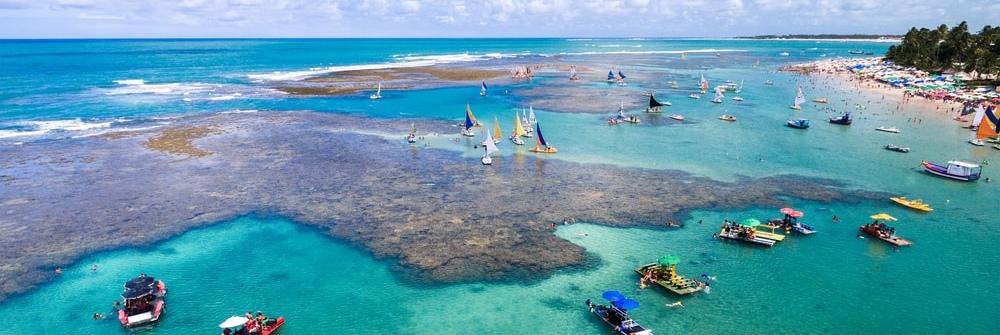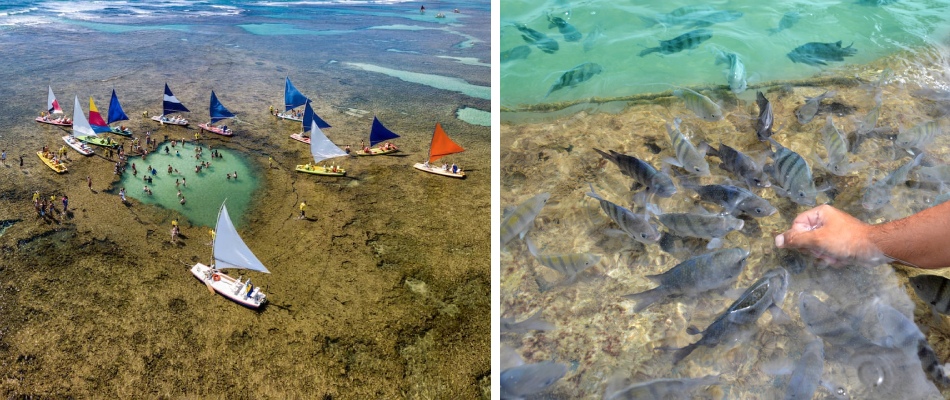The natural pools in Porto de Galinhas can be found at the central beach and clearly explain why this beach since 2001 has been cited as the best beach in Brazil.
The pools have formed due to the position of the sea and the huge reef which runs along the coastline for approximately 700 meters. The space created between the sea and the reef has enabled the formation of natural pools which the public are allowed to swim and bathe in (taking the tidal timetable into consideration) whilst surrounded by thousands of small fish.
It is important to know…
If you are unfortunately only able to spend a few days in Porto de Galinhas and you want to include a visit to the natural pools on your itinerary, take the following pieces of advice into consideration:
- Firstly: Take the time to learn how the tides and the tidal timetable works. Those people who arrive at high tide won’t find anything special at the central beach, because the reef will already be covered by water and it will be impossible to see. However, in order to be able to enter the natural pools, you must wait until the tide rises to at least 1m.
- Secondly: You are only allowed to stand on the parts of the reef that are indicated by ropes or by the people who are employed to take care of the reef. The reef is covered with very sensitive coral which we all have a responsibility towards.
There are two natural pools that are maintained and made open to the general public. In both pools, it is almost impossible to move thanks to the huge quantity of fish that are constantly swimming around you. Blitz Ambiental: the bracelet and the video

Blitz Ambiental: the bracelet and the video
Much of the time, and mostly during the high season, in order to enter the natural pools it is necessary to obtain a specific bracelet (which can be got for free). This bracelet can be found all along the central beach in small stalls marked “Blitz Ambiental.” Inside the stalls, you will have to watch a 3 minute video which explains all the necessary information for looking after the environment in the region and then you are given the bracelet to give you access to the pools themselves.
How to arrive to the pools
The natural pools are located only 200 meters away from the coastline, which means that they are easily accessible in two ways:
- By jangada: you can take what is known as a jangada (a small boat that is directed by the “jangadeiro” – the person who drives the boat).
- Swimming: it is also possible to arrive by swimming or walking to the pools, but it is imperative that you are a strong swimmer. Because, when the tide rises and it is time to return, the only way back will be by swimming and the waters, at this time of day, are always a lot stronger.
Advantages and Disadvantages of Going with the Jangada
If you visit the natural pools in Porto de Galinhas by jangada, it is not necessary to know how to swim, it is a great way for the entire family to enjoy the pools together and it is really easy to carry cameras in order to take photos or make videos of your experience.
If there are any disadvantages to be had from this mode of arrival, it is relatively obvious to highlight the fact that you have to pay for the service (even though the price is very low – approximately R$ 15,00 (4,00 Euros) and the “jangadeiro” will only wait for 30 / 40 minutes before taking you all back to where you started.
Natural Pools All Year Round
Owing to the wonderful climate in this region all year round (the temperature on average maintains a beautiful 29 degrees), the natural pools in Porto de Galinhas can be visited on any of the 365 days of the year. Whether there be sunshine or rain, nothing will stop you from enjoying the natural beauty of these pools.
The central beach in Porto de Galinhas is very popular with international tourists on the weekend. However, the beach is on average the favourite spot for natives from Recife and other parts of Brazil.

Recommendations
- At high tide, you must take care when swimming because the borders of reef tend to be sharp and are liable to cut you if you are not careful.
- Wear something on your feet (flip flops are a good choice) to protect them from the sea urchins on the reef.
- If you choose to swim to the pools, we recommend that you wear little clothing and carry almost nothing with you.
- Finally, and as we have already highlighted in this article, take the time to learn how to read the tidal timetable, because with a knowledge of this important information you can go ahead and better plan your activities during your stay.
